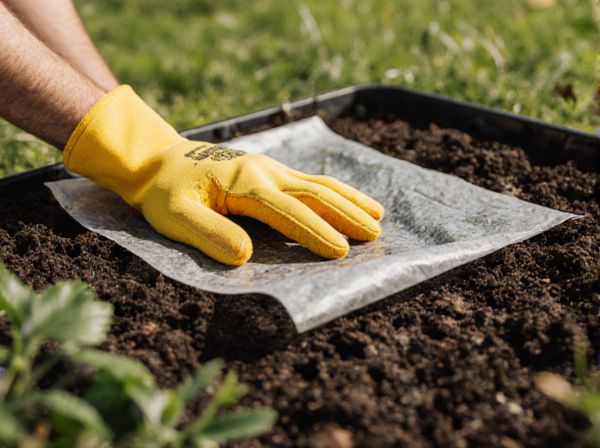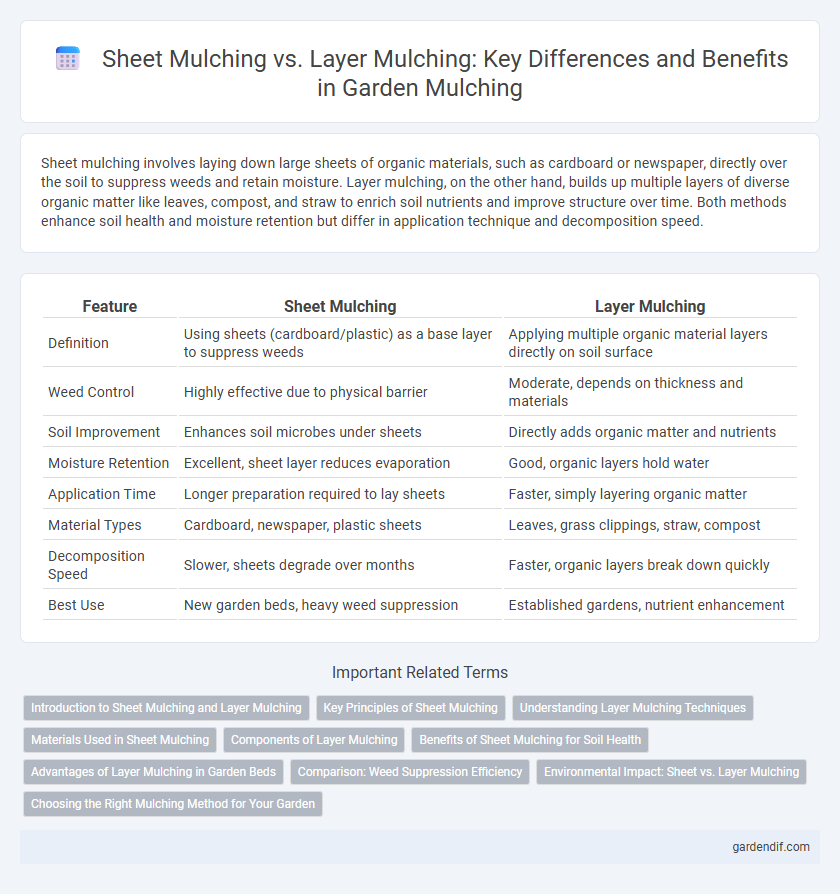
Sheet mulching vs Layer mulching Illustration
Sheet mulching involves laying down large sheets of organic materials, such as cardboard or newspaper, directly over the soil to suppress weeds and retain moisture. Layer mulching, on the other hand, builds up multiple layers of diverse organic matter like leaves, compost, and straw to enrich soil nutrients and improve structure over time. Both methods enhance soil health and moisture retention but differ in application technique and decomposition speed.
Table of Comparison
| Feature | Sheet Mulching | Layer Mulching |
|---|---|---|
| Definition | Using sheets (cardboard/plastic) as a base layer to suppress weeds | Applying multiple organic material layers directly on soil surface |
| Weed Control | Highly effective due to physical barrier | Moderate, depends on thickness and materials |
| Soil Improvement | Enhances soil microbes under sheets | Directly adds organic matter and nutrients |
| Moisture Retention | Excellent, sheet layer reduces evaporation | Good, organic layers hold water |
| Application Time | Longer preparation required to lay sheets | Faster, simply layering organic matter |
| Material Types | Cardboard, newspaper, plastic sheets | Leaves, grass clippings, straw, compost |
| Decomposition Speed | Slower, sheets degrade over months | Faster, organic layers break down quickly |
| Best Use | New garden beds, heavy weed suppression | Established gardens, nutrient enhancement |
Introduction to Sheet Mulching and Layer Mulching
Sheet mulching involves layering sheets of organic material, such as cardboard or newspaper, directly on the soil surface to suppress weeds and retain moisture. Layer mulching, also known as lasagna mulching, consists of alternating layers of green and brown compostable materials to enrich soil fertility and improve texture. Both methods enhance soil health but differ in their approach to organic matter decomposition and weed management.
Key Principles of Sheet Mulching
Sheet mulching involves layering organic materials such as cardboard or newspaper directly onto the soil surface to suppress weeds, retain moisture, and improve soil fertility through gradual decomposition. This technique relies on creating a breathable, biodegradable barrier that integrates with the soil ecosystem, promoting beneficial microbial activity and enhancing nutrient availability. Proper application requires overlapping sheets to prevent weed growth while maintaining adequate moisture and aeration for soil health.
Understanding Layer Mulching Techniques
Layer mulching involves applying multiple organic materials in successive layers, each serving a specific function such as moisture retention, weed suppression, and soil enrichment. Common layers include a base of cardboard or newspaper to block weeds, followed by nitrogen-rich green materials, carbon-rich brown materials, and a final mulch layer like straw or wood chips. This technique promotes soil health, enhances microbial activity, and improves nutrient cycling, making it a preferred method in sustainable gardening and permaculture.
Materials Used in Sheet Mulching
Sheet mulching primarily utilizes organic materials such as cardboard, newspaper, compost, straw, and wood chips to create a nutrient-rich barrier that suppresses weeds and improves soil health. This method often incorporates layers of green and brown organic matter to balance carbon-to-nitrogen ratios, enhancing decomposition rates. In contrast to layer mulching, sheet mulching emphasizes flat, continuous coverage using sheet-like materials to retain moisture and foster beneficial microbial activity.
Components of Layer Mulching
Layer mulching involves stacking multiple organic materials in distinct layers to improve soil health and moisture retention. The components typically include a base layer of cardboard or newspaper to suppress weeds, followed by alternating layers of carbon-rich materials such as dried leaves or straw, and nitrogen-rich materials like grass clippings or kitchen scraps. This method promotes beneficial microbial activity and enhances nutrient cycling compared to simple sheet mulching.
Benefits of Sheet Mulching for Soil Health
Sheet mulching improves soil health by creating a thick, protective barrier that suppresses weeds, conserves moisture, and enhances organic matter decomposition. This method promotes beneficial microbial activity and nutrient cycling, resulting in fertile, well-structured soil. Unlike layer mulching, sheet mulching integrates organic layers more effectively, boosting long-term soil vitality.
Advantages of Layer Mulching in Garden Beds
Layer mulching offers superior moisture retention and improved soil structure compared to sheet mulching by allowing organic materials to decompose gradually and enrich the soil. This method enhances aeration and supports beneficial microbial activity, promoting healthier plant growth in garden beds. It also reduces weed growth more effectively by creating a thicker, more stable barrier that smothers unwanted plants.
Comparison: Weed Suppression Efficiency
Sheet mulching offers superior weed suppression by creating a dense, impenetrable barrier that blocks sunlight, effectively preventing weed germination. Layer mulching, while beneficial for soil nutrition and moisture retention, may allow some weed growth due to less uniform coverage and gaps between organic layers. Studies show sheet mulching can reduce weed proliferation by up to 90%, outperforming layer mulching in long-term weed control efficiency.
Environmental Impact: Sheet vs. Layer Mulching
Sheet mulching significantly improves soil health by suppressing weeds, reducing erosion, and enhancing moisture retention through layered organic materials that decompose naturally. Layer mulching, while also beneficial for soil quality, may lead to slower decomposition rates and potential nutrient imbalances due to uneven layering of organic matter. Environmental impact assessments favor sheet mulching for its ability to create a more stable micro-ecosystem and promote biodiversity in garden and agricultural settings.
Choosing the Right Mulching Method for Your Garden
Sheet mulching involves layering cardboard or newspaper beneath organic materials to suppress weeds and improve soil structure, making it ideal for establishing new garden beds. Layer mulching consists of applying successive organic layers directly on the soil surface, enhancing moisture retention and nutrient cycling, which suits established gardens requiring ongoing soil enrichment. Selecting between sheet and layer mulching depends on your garden's condition, with sheet mulching providing a strong weed barrier and soil amendment, while layer mulching promotes gradual soil health improvement.
Sheet mulching vs Layer mulching Infographic

 gardendif.com
gardendif.com